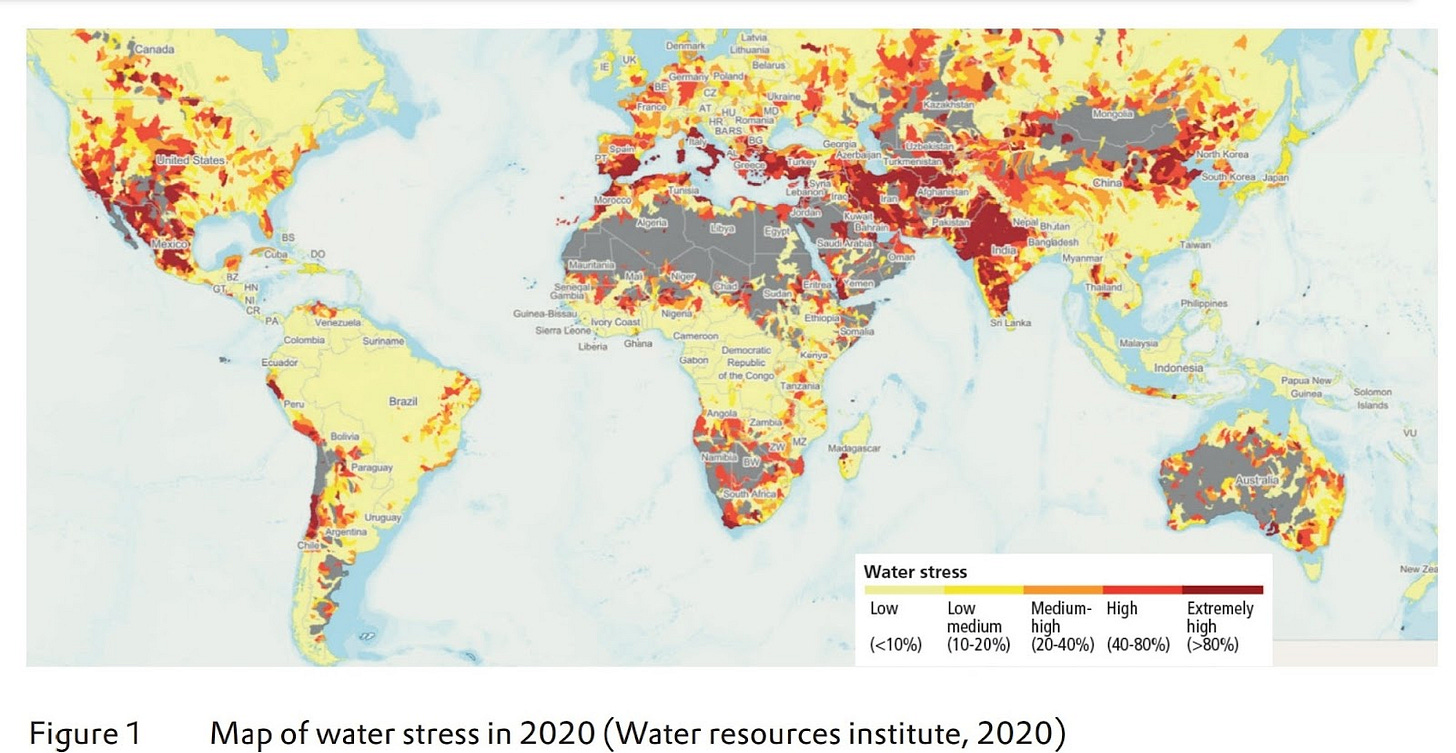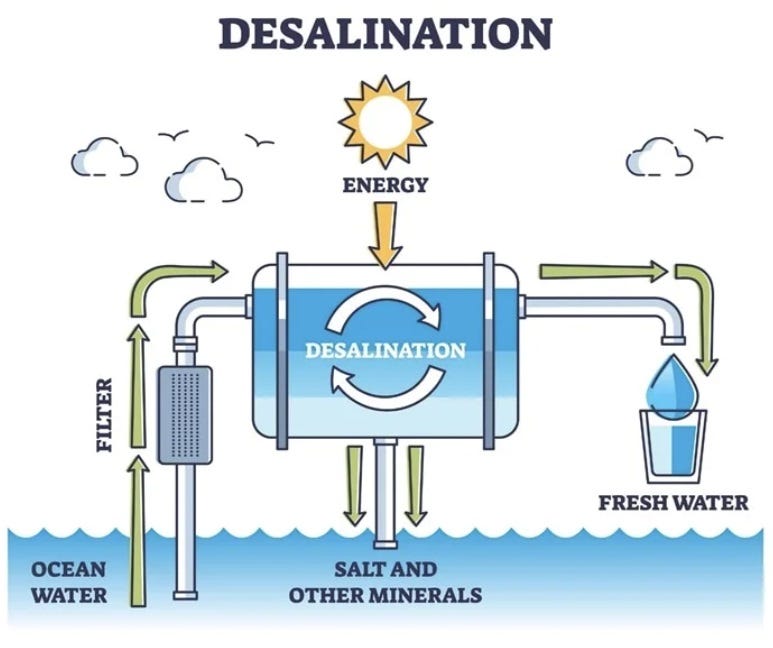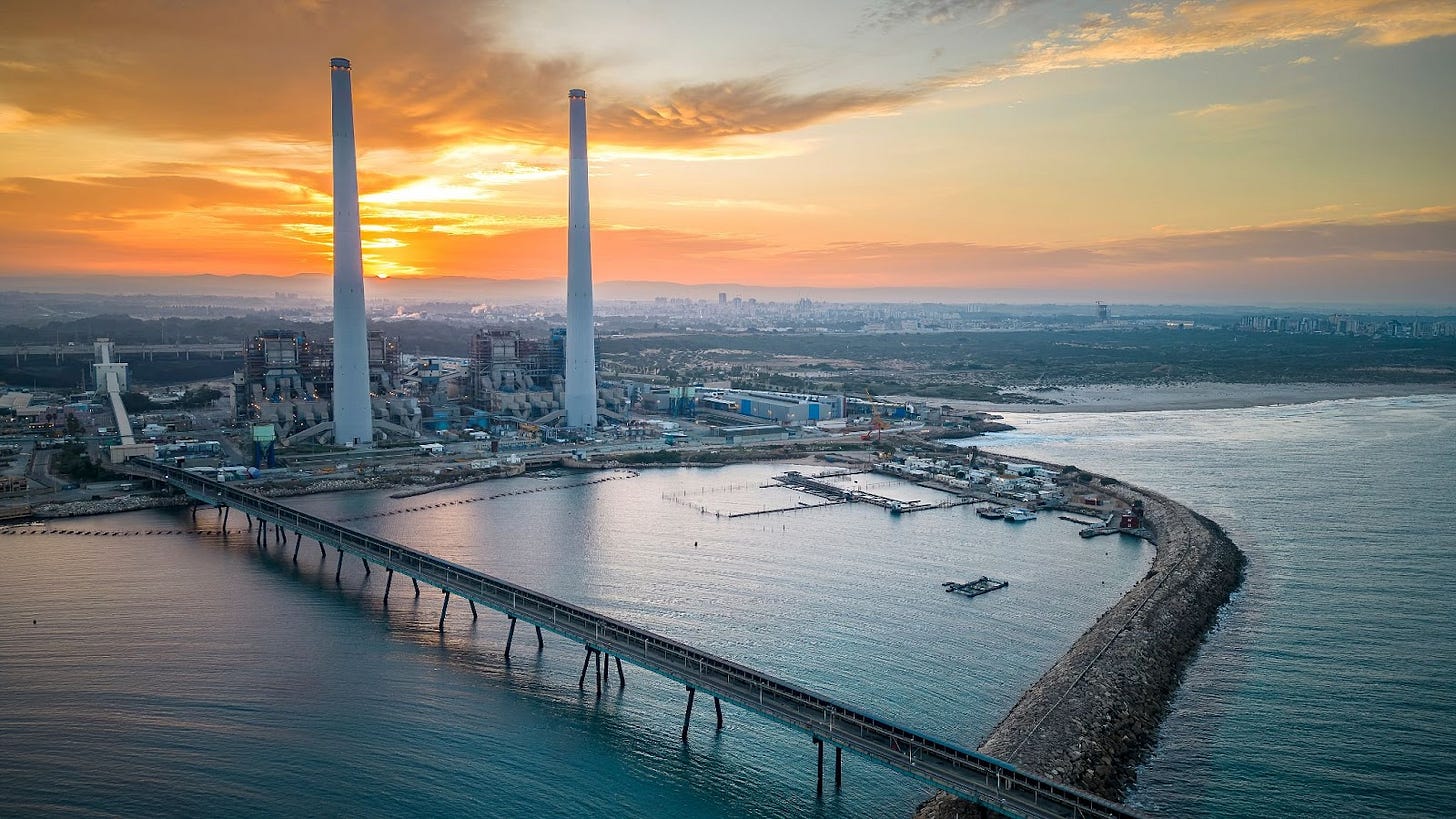We can solve water scarcity, but it's going to need a lot of energy
Clean energy can power data centres. Desalination needs it too
“Water, water, every where / And all the boards did shrink / Water, water, every where / Nor any drop to drink” - The Rime of the Ancient Mariner, Samuel Taylor Coleridge, 1797–98
Many of us take access to clean drinking water for granted. While some people complain about this, I actually think it’s a good thing because it means that we don’t know what it’s like to experience deadly dehydration. That said, we should also think beyond the needs of the short term and avoid becoming complacent about important issues like the growing need for clean water.
Water stress gets a lot of media attention but is seldom presented with an accompanying solution, as if it is inevitable and inescapable. With news that the Three Mile Island nuclear power plant is due to reopen in order to power Microsoft data centres, people are catching on to the idea that we need more energy to power AI - but what about the need for clean water?
According to the United Nations, 2.2 billion people globally currently lack access to safe drinking water, and for an increasing proportion of humanity freshwater is in short supply. Although roughly 71% of the Earth is covered in water, only 2.5% of it can be used for consumption and to water crops.
As well, the supply of available freshwater is in decline due to droughts becoming more common, and the 1.1 billion people who inhabit the world’s driest regions are at the most risk of experiencing water scarcity. When most people think of water stress, they imagine death from dehydration, but water scarcity also impacts food production and causes diseases to spread. In regions of the world affected by water stress, yield gap closure depends on sufficient irrigation, and some researchers estimate that demand for water for crops is likely to increase by at least 146% by the middle of this century. Water scarcity also leads to sanitation problems that result in water-borne illnesses, such as typhus and cholera.
As the poet Coleridge once lamented, water is everywhere, but we usually can’t drink it. Thankfully, humans are innovative creatures, and there are various methods of converting saline water into freshwater. We already know that in order to turn seawater into drinking water, we have to remove the dissolved salt. This requires distillation, which is the process of boiling seawater, capturing the steam, and condensing it back into water. What doesn’t get enough attention is one of the most effective methods of cleaning up vast quantities of water - through the process of desalination.
What is desalination?
The concept of desalination is not new. In 350 BCE, the Greek philosopher Aristotle observed that “salt water, when it turns into vapour, becomes sweet, and the vapour does not form salt water again when it condenses.”
Desalination is one of the oldest forms of water treatment - in ancient times, it was used on ships to convert seawater into drinking water. There are several different methods that achieve the same outcome, including reverse osmosis and thermal desalination.
The first patent for desalination was granted in 17th century England, and Britain built the first seawater distillation plant in Yemen back when the country was a British colony. For many years, the technology was neglected, but it was later revived by an unlikely candidate - the island of Aruba, in 1930.
Desalination plants typically last 30–60 years or more, although the lifespan depends on the type of technology used. Plants also only take a few years to build.
Who is building desalination plants?
For parts of the world where freshwater is not readily available, desalination is a life saving, thirst quenching technology. There are currently almost 20,000 desalination plants in operation around the world, some of which are small production plants serving residential or private industrial areas, and others are large plants that supply the population or industry.
The potential for desalination plants to deliver water is tantamount to the invention of aqueducts, which enabled the Romans to settle lands far from water sources. Over half of all desalination plants are in the Middle East, where the largest plants are located in the United Arab Emirates, Saudi Arabia, and Israel.
In 1998, the Middle East was hit by a drought that lasted over ten years - the worst it had experienced in 900 years. The drought heavily hit farmers in countries like Israel, Jordan, Turkey, and Lebanon. In 2000, Israel came up with a response to water stress, launching a Desalination Master Plan to provide drinking water to its population. The plan set out the target of producing 1,100 million m³ of desalinated water per year by 2030 and announced five large desalination plants. These plants now supply almost all of the country’s tap water. Israel later became a net exporter of water and producer of the cheapest desalinated seawater on Earth.
Nowhere is safe from water scarcity- the American Southwest is experiencing a new era of extreme heat, drought and aridification, and drought impacting the Mississippi River coupled with a long history of dredging by the Army Corps of Engineers has contributed to problems with drinking water in populous cities like New Orleans.
The US initially invested heavily in desalination technology, but due to rising costs, many plans to build plants were abandoned. Micro desalination plants are common in the US near natural gas and fracking facilities, and the majority of desalination plants are in California, Florida, and Texas. The largest desalination plant in the US is the Carlsbad Desalination Plant in California. It creates over 50 million gallons of freshwater a day, which is used by the approximately 3.1 million people in the region, but it cost $1 billion to build and maintain.
Within Europe, desalination plants are mainly found in Mediterranean countries, and Spain is one of the world's largest users of desalination. In Asia, Singapore, Australia, India and China have developed desalination programs. Australia also has desalination plants.
Some of the case studies of desalination technology are remarkable. The island of Aruba has an average rainfall of fewer than 20 inches per year, so water availability has been taken seriously by this typically dry country and water needs have been met by desalination since the 1930s when the first desalination plant of its kind - converting seawater to drinking water - was built. Desalination now provides the island's only source of drinking water, which is an impressive feat for a country populated by 100,000 people that attracts over 700,000 tourists every year. Aruba boasts that it has some of the best water in the world.
Salty truths
Since we have the solution and we know that water scarcity is a growing problem, why aren’t countries building more desalination plants?
It may not come as a surprise to you that the main barriers to building desalination plants are cost and environmental concerns.
The waste brine created by desalination plants is a highly concentrated salt water byproduct that contains chemical residues like coagulants. As ever, environmentalists have used this to object to proposed projects, for example in 2022, a 20-year plan to build a desalination plant at Huntington Beach in California was declined by the California Coastal Commission over concerns relating to waste disposal and the environmental impact of brine.
Since valuable minerals and elements can be extracted from the brine, including gold, silver, lithium, copper, magnesium, potassium and bromine, it could be a valuable resource. Ultimately, a more definitive solution needs to be created for the waste, which - dare I say it - is only waste if we waste it.
The other snag is the cost, which is due to the fact that desalination requires a lot of energy to run. Although energy requirements to desalinate one unit of seawater have been declining during the past two decades, plants are still highly energy intensive. This could easily be addressed by powering desalination plants with clean and reliable nuclear power plants. One study notes that “there has been virtually no discussion or appreciation of making desalination infrastructure to be carbon neutral”. While the dialogue around the need to power AI data centres moves forward quickly, the discussion around desalination has stagnated for years.
Finally, plants are large infrastructure projects, and Western countries are currently not very good at building large-scale facilities, which require upfront investment, experienced workers, and long term commitment to building and maintenance. Perhaps that is why desalination is rarely discussed, but since we know that water scarcity is going to worsen globally, and we know that water stress drives migration - which many Western countries are concerned about - it makes sense to finance and build these plants now in large numbers, especially in areas that are already prone to water stress.
As President John F Kennedy once said at the opening of the desalination plant in the US, it is “a work that in many ways is more important than any other scientific enterprise in which this country is now engaged.” It’s notable that he said this during the space race. I’m all for reaching for the stars, but to achieve such goals we need to ensure the very basics of survival for humankind first, and that means ensuring long term access to drinking water, especially in those regions where the technology is needed most. Let AI data centres have their own nuclear power plants, and let’s see some enthusiasm for building desalination plants alongside them too.








Samuel Coleridge summed up the problem in 1797 in 'Rime of the Ancient Mariner' when the mariner states "water, water everywhere, and not any drop to drink". The problem we have is that while our world has huge amounts of water, most of it is not potable. Adding to the difficulty, what fresh water we have is all too often polluted or contaminated. Worse, in some places, fresh water is wasted on activities that have nothing to do with human or agricultural consumption.
Zion is right to note that this is a serious problem. Fixing this problem requires energy to desalinate it and to remove pollutants, either chemical or biological.
Worse still are the economics of water supply. The world's people in need of clean water are often those least capable of paying for the cost of desalination and pollution abatement. The requirement to fix all this required energy, lots of it.
Given the size and scale of the problem, this energy can only come from a few sources in the form of electricity: fossil fuels or nuclear power. Renewable sources such as wind/solar cannot meet this demand. And it makes little sense to use fossil fuels for desalination when nuclear power is available and can be used for this task.
And let's not forget that nuclear submarines and aircraft carriers have been desalinate sea water for years. Here's an excerpt from a study conducted by the MIT Center for Energy & Environment Policy Research regarding how the Diablo Canyon Nuclear Power Plant's (located in Southern California) energy could be used in addition to producing electricity. https://tinyurl.com/bdxwksux
"Diablo Canyon could serve as a powerful driver of low-cost desalination to serve fresh water to urban, industrial and agricultural users. The site could operate a desalination plant equal in size to the state's largest desalination plant in Carlsbad – or much larger – at about half the cost per gallon of freshwater produced."
Today AI and data centers are discovering nuclear energy as a viable solution to power their operations. Not just because of low CO2 emissions, but also because of nuclear energy's high capacity factor, and not being dependent on a just-in-time fuel source. Desalinating sea water, and treating waste water could be another area where nuclear energy thrives behind the meter. The need is certainly pressing.